Why does the LED light glow when the switch is off?
You turn off the lamp in the evening, but it continues to burn. It’s so dim, not very bright, but it’s on and doesn’t want to turn off at all. No, it’s not all about the drum and it’s not even a hallucination. The point is completely different. LEDs often light up even if you turn off the current. It doesn’t seem to harm your health, but they break down much faster, because the load on them is constant.
The reason may be old and already worn out insulation, and some design features of the lamp itself. In a word, you need to figure it out.
The content of the article
The design and principle of operation of an LED light bulb
To understand the reason for the glow, you need to find out what is inside the LED lamp and understand how it works.
Despite its modest size, this device is quite complex. The following elements are installed inside:
- LEDs. This is the basis of this entire lighting fixture. It is from them that the light comes that makes us so happy.
- Printed chip from a heat-conducting mass. This element transfers excess heat to the radiator, which allows you to maintain a temperature inside the lamp at which all its components operate stably.
- Radiator. Takes on all the excess heat.
- Base. Allows you to screw the lamp into the socket. The base is made of brass, over which nickel is applied.
- Base. In direct contact with the base is the base of the lamp, which is made of polymers. This allows you to protect the housing from electric current.
- Driver. Thanks to this element, the device can operate stably, even if the voltage in the network fluctuates. In essence, this is a kind of voltage stabilizer.
- Diffuser. A glass hemisphere that covers the lamp at the top and allows the light flux emitted by the lamp to be diffused.
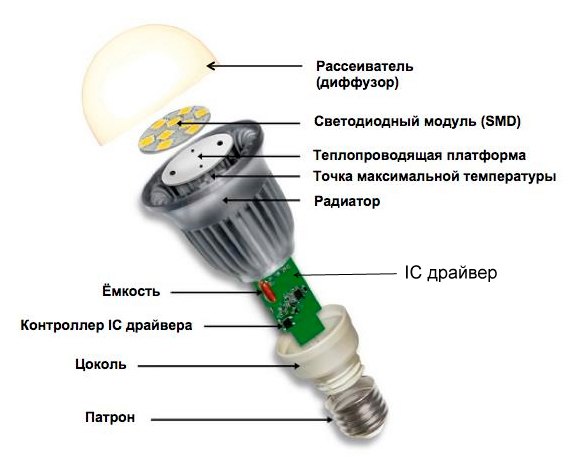
All elements of the device are interconnected with each other, which allows it to work reliably.
LED Bulb Basics
The design of LED lamps from different companies can differ greatly from each other. However, the principle of operation is the same for all. If you draw a diagram, it will look like this:
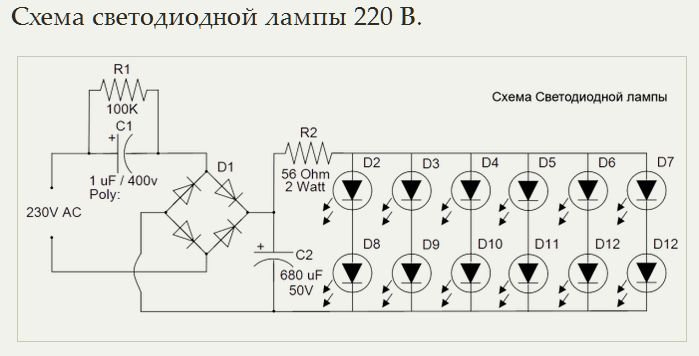
As soon as the lamp is turned on, the electrons inside the bulb begin to move chaotically under the influence of electricity. And when an electron collides with another, at the point of contact of semiconductors, electrons are converted into photons. They are the ones who create light.
To optimize this entire procedure, transistors or other current-limiting elements are installed inside the structure.
Why does an LED light bulb glow when it's turned off?
In fact, there are many reasons why the LED resists and does not want to go out despite the fact that the switch tells it to do so.
Among the most frequently encountered ones are the following:
- Poor quality wiring is a very common cause. Perhaps it has simply become dilapidated, or the insulation has been damaged somewhere on the wire.
- The device was incorrectly connected to the electrical circuit.
- Sometimes those beloved backlit switches become the culprits when the LEDs do not respond to the switch.
- Poor quality lamp. This is how he shows his character.
Each case should be considered separately.
Switch with backlight function
If the LEDs are constantly on and it has simply turned into a mania, the first thing you need to pay attention to is, oddly enough, the switch itself. As electricians say, and they know for sure, very often the cause of the problem is a switch with built-in lighting.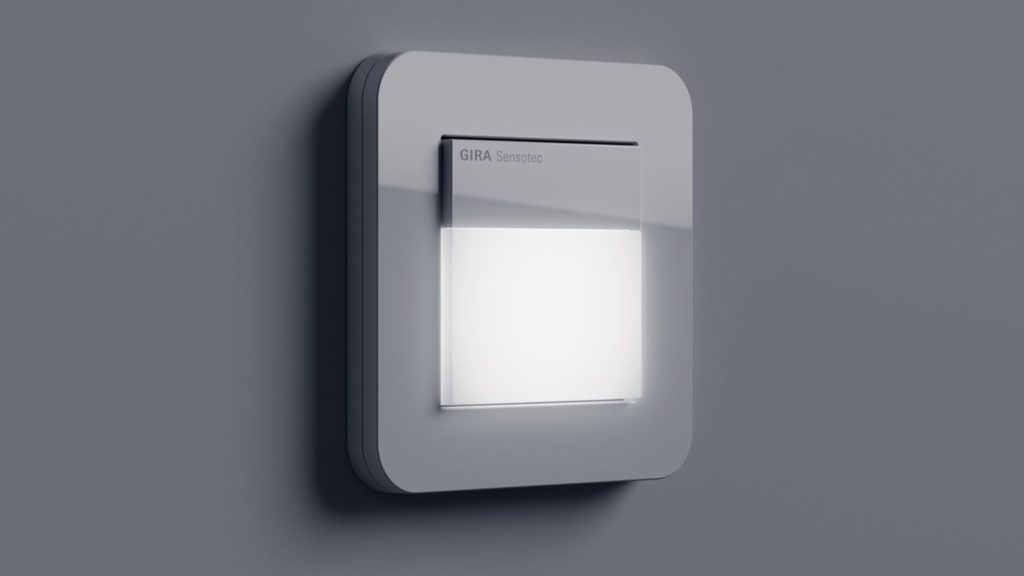
There is a banal conflict going on here. The switch is not able to de-energize the entire electrical circuit, since there is a backlight that receives power from the resistance. Since the circuit is, in fact, not closed, some of the voltage is supplied to the lamp - hence its glow.
Reference. The same situation may arise if there are other, similar devices. Timers, photocells, light and motion sensors.
Considering that this situation occurs quite often, electricians have long found several options for solving it.
You can correct the situation in the following ways:
- replace switches;
- turn off the backlight;
- install an additional resistor;
- screw a weaker light bulb into the lighting fixture;
- install a resistance that has greater power.
Of all the above, the easiest way is to change the switches to classic ones, without any backlight. But these are extra financial costs, and you also need to spend additional time dismantling the switch and installing another one.
If having a backlight in the switch is not particularly important, then take a pair of wire cutters and cut through the resistance from which this backlight is powered. If the backlight must be left on, a shunt resistor should be included in the circuit.
To install it, you need to disassemble the lamp, find the terminal block and attach the resistor wires to it.
Thus, the electricity that goes through the LED will no longer pass through the driver capacitor, but will be directed to the installed resistor. This will prevent the resistance from receiving recharging and all the lamps will begin to go out as soon as the switch is pressed.
If a similar problem occurs in a chandelier that has several bulbs, then one of them can be safely replaced with a similar, but weaker one. It will begin to collect all the electricity that comes from the capacitor.
You can do the same thing with a chandelier for one lamp, you just need to purchase and install a splitter from one light bulb to two. But if you use this method, one of the bulbs will still glow.
Wiring faults
Very often, worn-out and long-dilapidated wiring is the reason that energy-saving lamps do not turn off. If there are doubts about the integrity of the insulation, simply apply high voltage electricity to the device for a while, thereby recreating the situation with a breakdown in the network.
To find a damaged area in hidden wiring, you can use special devices that are designed for this purpose.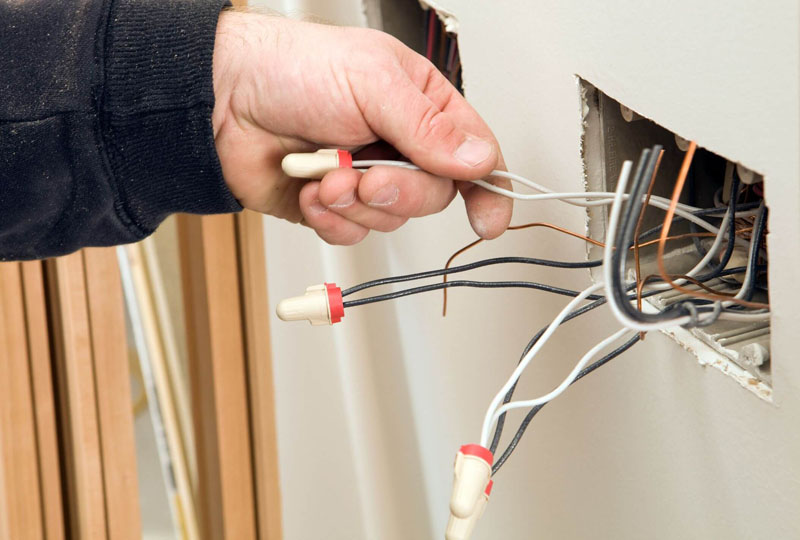
If it really is all about poorly functioning wiring, then it's time to change it. If it is laid in an open way, then this is a quick job - it won’t take much time. It's worse if the wiring is hidden.
Here you will first have to tinker to remove all the finishing, for example, wallpaper and plaster. After this, the groove is opened, in which the cable is located. Next, you need to either partially replace the damaged piece, or, more correctly, the entire wiring system. After this, the cable must be hidden again, a layer of plaster applied on top and wallpapered.
As a temporary solution, you can install a relay that will provide additional load. Such devices, which have lower resistance than LEDs, are connected in parallel with lamps.
The relay will help redirect the electric current, due to which the functioning of the lamps will be restored. When turned off they will go out immediately.
Incorrect connection of the lamp
If you make a mistake in connecting the lamp, it may well stop turning off and continue to glow. If during installation of the switch you confuse the phase with zero, it will open the circuit and the lamp will turn off.
But the phase has not gone away. All wiring remains energized, so the lamp can safely continue to burn despite the fact that you clicked the switch a long time ago.
It's actually quite a dangerous situation. After all, the device is constantly under current. Despite the fact that it is supposedly turned off, as everyone believes, it is still possible to receive a discharge of electricity from it. It would be better to turn off the power to the entire room, disconnect all the wires and connect them as they should have been done in the first place.
Low quality light bulb
Often the reason that the lamp blinks when the electricity is turned off is trivial and lies in the poor quality of the LED itself. Simply installing a quality part is enough.
Reference. To avoid getting into such situations, it is better to purchase products from manufacturers that have proven themselves successfully for a long time, and these are Philips, Gauss or ASD. Of the domestic manufacturers, Jazzway and Era performed well.
But you should keep in mind that even products from famous brands can have a self-glow effect.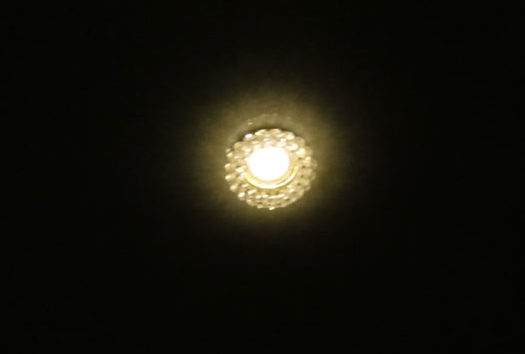
This is especially true of the resistors used in lamps.
When power is supplied to the device, heat energy accumulates in it. It is for this reason that the LED can continue to glow even when the electricity has already been turned off. But, really, not for very long. Manufacturers are trying to get rid of this phenomenon and use resistors in the production of their products, which are made on the basis of materials that do not allow excess thermal energy to accumulate.
What to do if the light is on or blinking when the light is off
Whatever the reason for this behavior, the fix is quite simple. You should take a capacitor and connect it parallel to the light bulb, and it is best to do this at the terminal block of the lighting device. If backlit switches are used, then the capacitor should have a capacity of approximately 0.1 μF, sometimes 0.047 μF is enough. The voltage at which the capacitor can operate should not be less than 400 V, it is better if it is more - 600 V.




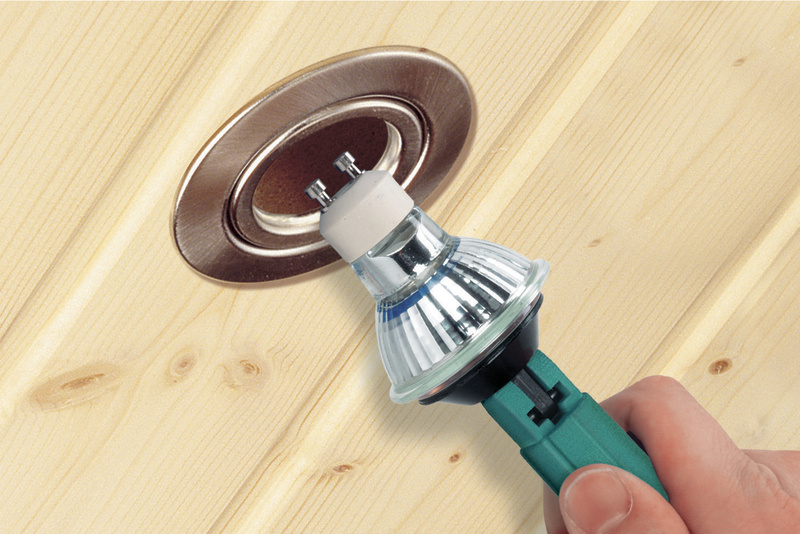

The topic was raised well, but the presentation is lame on all legs.
“As soon as the lamp is turned on, the electrons inside the bulb begin to move randomly under the influence of electricity. And when an electron collides with another, at the point of contact of semiconductors, electrons are converted into photons. They are the ones who create light.”
What was it about? What electrons are “inside the flask”? Where are they moving there? Which contact"? There is only one semiconductor crystal and the only other thing is that it has a doped zone, which forms a p-n junction that emits light.
What new “materials” have you come up with for resistors? All resistors are always made on a ceramic base; a thin film of the resistive layer cannot create any “accumulation” of heat. And the sizes of the resistors are not enough to accumulate something in themselves. You don’t know the principle of the design and operation of an LED, but are you trying to speak out like a serious specialist? Why are you misleading people?
What is “heat energy”? And why does this “energy” not manifest itself in any way when a phase wire breaks?
Do you know that exactly the same effect is observed in fluorescent lamps with an “electronic choke”? There is definitely no “heat accumulation” there.
Everything is much simpler. A weak glow or periodic weak flashes occur if the connection is incorrect only because there is a weak capacitive connection of the wires to the ground that cannot be eliminated by any means. Therefore, a charge gradually accumulates in the smoothing capacitor, which leads to a flash when the LED ignition voltage is reached, which discharges the capacitor.A weak constant glow is evidence of a sufficiently large capacitance, that is, a long length of the “zero” wire and a very short distance from the ground, while a sufficiently large parasitic capacitance maintains sufficient leakage current to constantly maintain the charge of the capacitor.